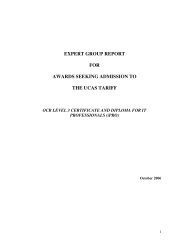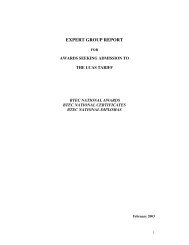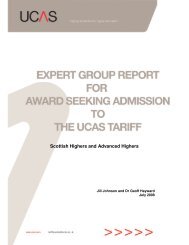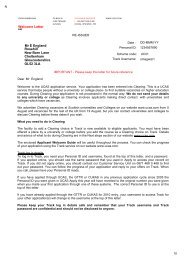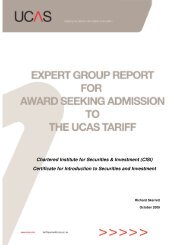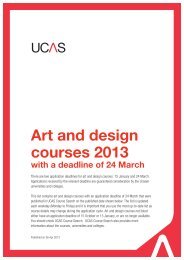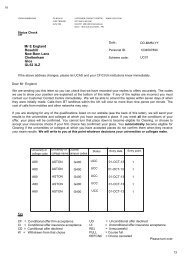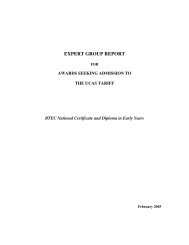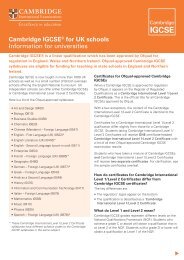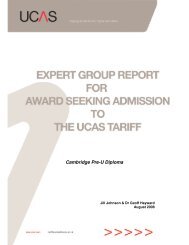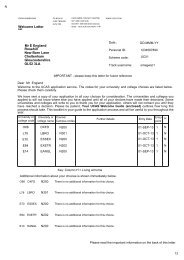International qualifications 2013 (pdf) - CUKAS
International qualifications 2013 (pdf) - CUKAS
International qualifications 2013 (pdf) - CUKAS
Create successful ePaper yourself
Turn your PDF publications into a flip-book with our unique Google optimized e-Paper software.
Qualifications currently offered<br />
GRADING SYSTEM<br />
10 Distinction<br />
9 Outstanding<br />
8 and 7 Very Good<br />
6 Good<br />
5 Pass (allows access to Spanish universities)<br />
Under 5 Fail<br />
Bachillerato assessments are marked either numerically between<br />
0 and 10 (the pass mark is 5 or above) or qualitatively, with a<br />
numerical equivalent assigned to each grade.<br />
The average Bachillerato mark (Nota Media del Bachillerato) is<br />
the mathematical average of the sum of the individual subject<br />
marks and is recorded to within two decimal places.<br />
Subject marks are usually an average of three internal<br />
assessments in each year. This average grade, expressed in<br />
numbers, as above, is shown on the certificate. The specialisation<br />
will be noted and also the mean mark covering all subjects taken<br />
in the two years of the Bachillerato.<br />
EDUCATION SYSTEM<br />
The Ministry of Education controls the general policy,<br />
inspectorate, validation and curriculum development, but there is<br />
considerable devolution in detail to 17 ‘autonomous’<br />
communities. The Graduado en Educación Secundaria<br />
(compulsory education) is taken at the end of ten years of<br />
compulsory education (six years of primary and four years of<br />
secondary). This is at age 16. Pupils may then embark on a twoyear<br />
course leading to the Título de Bachiller.<br />
The Bachillerato studies are organised in three broad specialities<br />
(modalidades): arts; humanities and social sciences; and science<br />
and technology (although schools offer a range of slight subject<br />
variations for each). Pupils may alternatively embark on a twoyear<br />
vocational course (different specialities) leading to the Título<br />
de Técnico de Grado Medio.<br />
ACCESS TO HIGHER EDUCATION<br />
Holders of the Título de Bachiller are qualified for admission to<br />
university in Spain provided they also pass the entrance<br />
examination (Prueba de Acceso a la Universidad or PAU). The final<br />
mark for university entry is made up of 40% from the PAU and<br />
60% from the average Bachillerato mark. An overall average of at<br />
least 5 out of 10 is required.<br />
From 2010 onwards, the PAU has been split into two parts: a<br />
compulsory group of four or five tests set jointly by the<br />
universities of each autonomous community, called the General<br />
Phase, and an Optional Specific Phase in subjects related to the<br />
degree course being applied for. The Specific Phase is weighted<br />
by individual universities and can add up to four additional points<br />
to the overall Access Score. In practice, the General Phase +<br />
Bachillerato alone will be sufficient for the great majority of<br />
degree courses but for high demand degrees such as medicine<br />
or architecture, universities can effectively raise the mark spread,<br />
and consequently course access scores, to a maximum of 14<br />
instead of the maximum of ten spread provided by the General<br />
Phase + Bachillerato.<br />
The PAU is not needed for Vocational Studies of advanced level,<br />
which can also be followed after the Bachillerato and lead to a<br />
Técnico Superior qualification after two years of study.<br />
There is an approved average comparison between UK/Spanish<br />
marks, published in BOE and used by Spanish universities to<br />
accept British educated students:<br />
BRITISH QUALIFICATIONS FOR DIRECT ACCESS TO<br />
SPANISH UNIVERSITIES<br />
g<br />
Students must have a minimum of five GCSE or IGCSE<br />
with marks A, B or C.<br />
g<br />
A minimum of two full GCE A levels with marks A*, A, B,<br />
C, D or E<br />
Each complete A level and AS level is given its UCAS Tariff<br />
value, and these are added together to give a total. For<br />
example:<br />
Spanish A level: A*<br />
Art A level: B<br />
ICT A level: B<br />
French A level: A<br />
English AS level: C<br />
Media Studies AS level: B<br />
Ranking: 140+100+100+120+40+50= 550<br />
The total Tariff points are converted into a two decimal number<br />
between five (140 Tariff points) and 10 (greater than 620 Tariff<br />
points), according to the table published in BOE by the Spanish<br />
Ministry of Education. This provides a direct correspondence as<br />
follows:<br />
UCAS Spain<br />
140 5<br />
160 5.2<br />
180 5.4<br />
200 5.6<br />
220 5.8<br />
240 6<br />
260 6.2<br />
280 6.4<br />
300 6.6<br />
320 6.8<br />
340 7<br />
360 7.2<br />
400 7.6<br />
420 7.8<br />
440 8<br />
460 8.2<br />
480 8.4<br />
500 8.6<br />
520 8.8<br />
540 9<br />
560 9.2<br />
580 9.4<br />
600 9.6<br />
620 9.8<br />
>620 10<br />
Students who want to attend Spanish universities can also<br />
choose to take the exam for the Fase Específica to increase<br />
their mark. This would allow students an extra four points in<br />
their overall qualification. Students can take as many subjects<br />
as they wish from the list of subjects which qualify for the Fase<br />
Específica.<br />
Higher Qualification Degrees in Spain<br />
Grado or First Degree lasting 4 years (240 ECTS credits). All<br />
Grados will belong to one of five families and all degrees within<br />
a family will have a common first year. The remaining three<br />
years will be designed by the university concerned.<br />
Before Bologna, the higher education system was divided into<br />
Diplomas or Ingeniero/Arquitecto Técnico (3 years) and<br />
Licenciaturas/Ingeniero o Arquitecto (5 years).<br />
56 INTERNATIONAL QUALIFICATIONS



